Managing Innovation: Business Model Literature Review Analysis
VerifiedAdded on 2020/05/11
|9
|2719
|403
Report
AI Summary
This report presents a comprehensive literature review on managing business innovation, exploring its definition as the translation of business ideas into valuable goods or services. The review delves into evolutionary and revolutionary innovation, emphasizing the significance of business model innovation as a source of competitive advantage. It discusses various aspects, including the industry, enterprise, and financial models, and highlights examples like Apple and Netflix. The report also examines the 4-dimensional concept and the business model canvas as frameworks for understanding and implementing business model innovation. It concludes by emphasizing the importance of continuous innovation in today's rapidly changing business landscape and the benefits of disruption for both businesses and society, citing Uber, Amazon, Netflix, and Airbnb as examples.
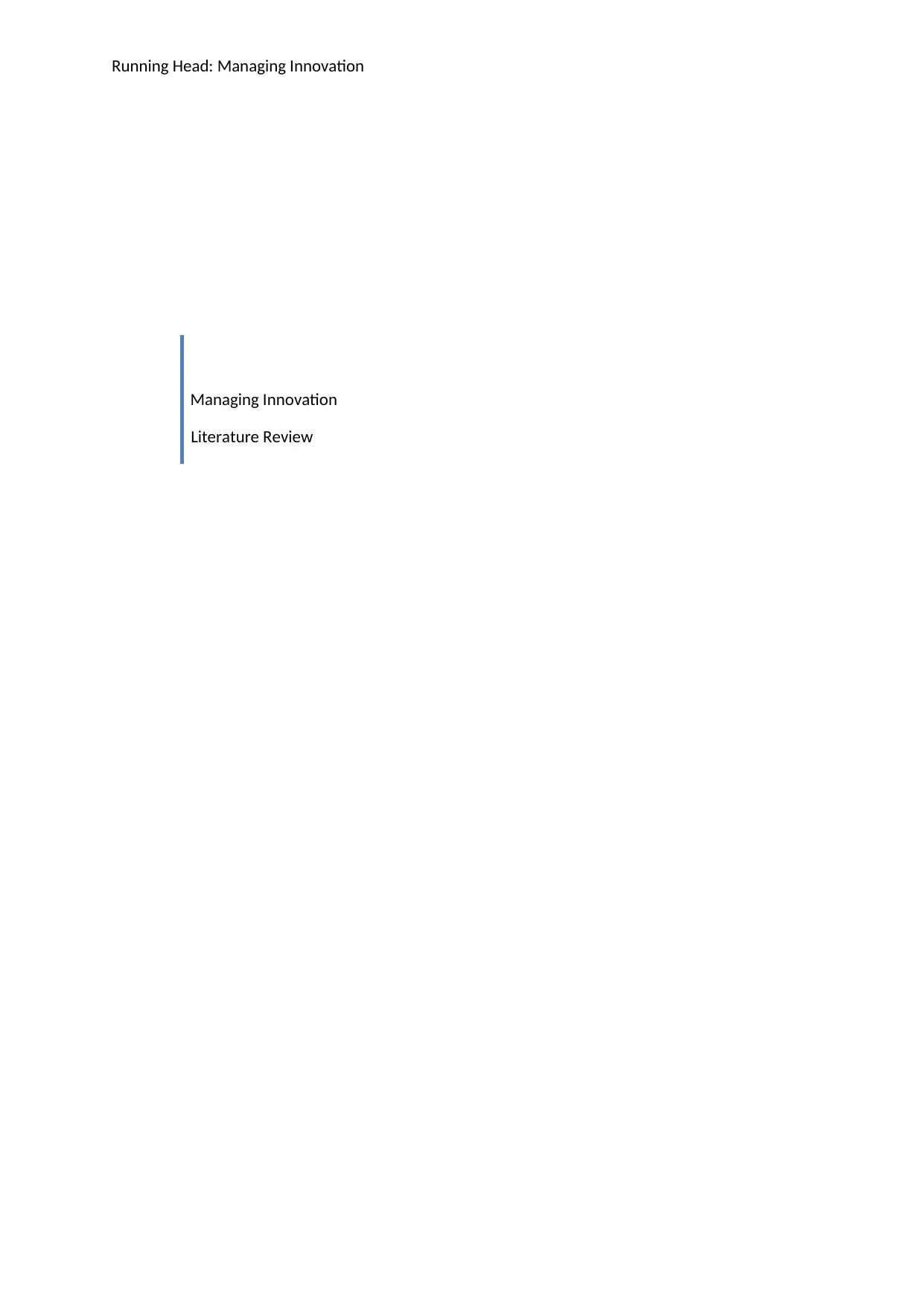
Running Head: Managing Innovation
Managing Innovation
Literature Review
Managing Innovation
Literature Review
Paraphrase This Document
Need a fresh take? Get an instant paraphrase of this document with our AI Paraphraser
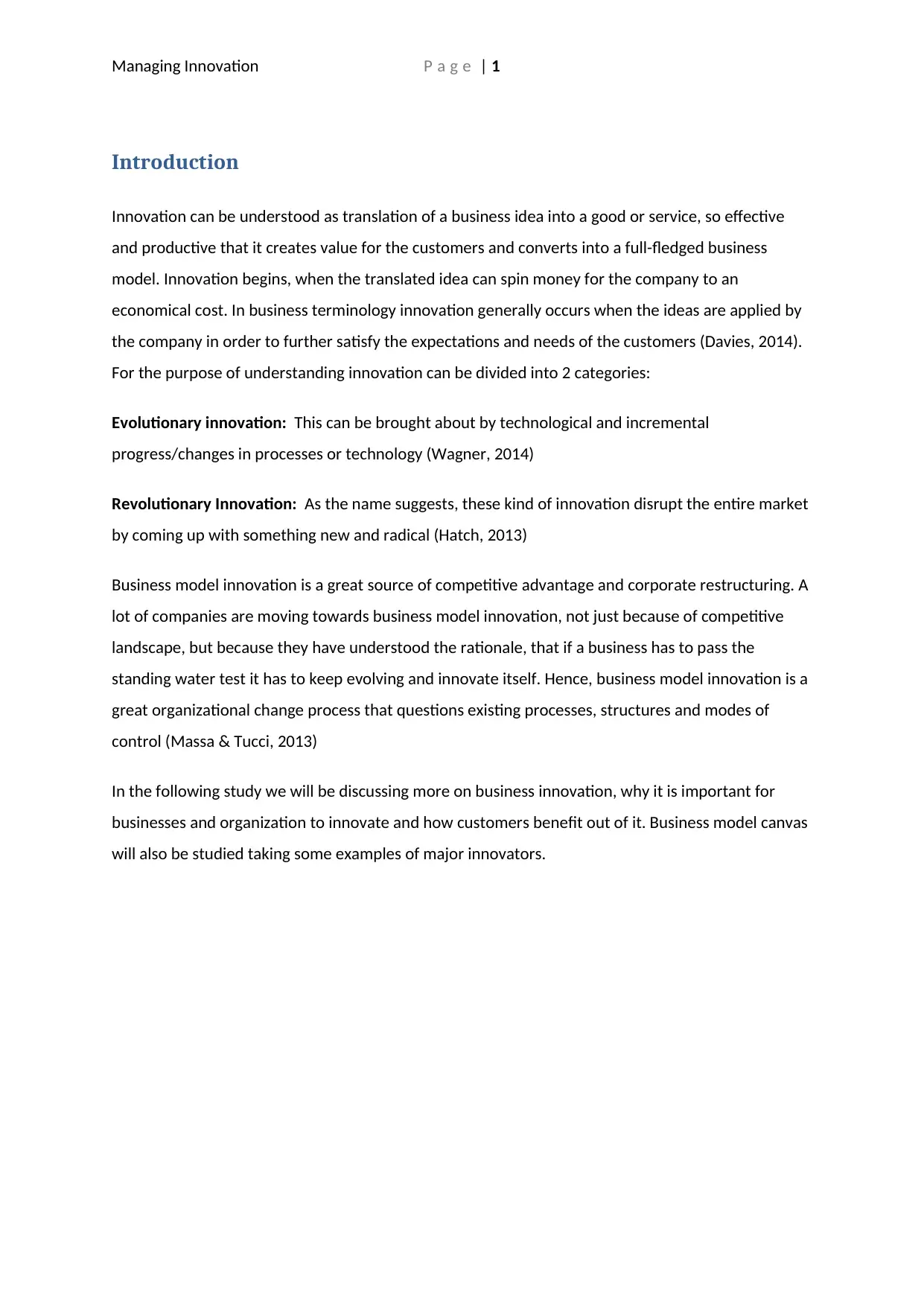
Managing Innovation P a g e | 1
Introduction
Innovation can be understood as translation of a business idea into a good or service, so effective
and productive that it creates value for the customers and converts into a full-fledged business
model. Innovation begins, when the translated idea can spin money for the company to an
economical cost. In business terminology innovation generally occurs when the ideas are applied by
the company in order to further satisfy the expectations and needs of the customers (Davies, 2014).
For the purpose of understanding innovation can be divided into 2 categories:
Evolutionary innovation: This can be brought about by technological and incremental
progress/changes in processes or technology (Wagner, 2014)
Revolutionary Innovation: As the name suggests, these kind of innovation disrupt the entire market
by coming up with something new and radical (Hatch, 2013)
Business model innovation is a great source of competitive advantage and corporate restructuring. A
lot of companies are moving towards business model innovation, not just because of competitive
landscape, but because they have understood the rationale, that if a business has to pass the
standing water test it has to keep evolving and innovate itself. Hence, business model innovation is a
great organizational change process that questions existing processes, structures and modes of
control (Massa & Tucci, 2013)
In the following study we will be discussing more on business innovation, why it is important for
businesses and organization to innovate and how customers benefit out of it. Business model canvas
will also be studied taking some examples of major innovators.
Introduction
Innovation can be understood as translation of a business idea into a good or service, so effective
and productive that it creates value for the customers and converts into a full-fledged business
model. Innovation begins, when the translated idea can spin money for the company to an
economical cost. In business terminology innovation generally occurs when the ideas are applied by
the company in order to further satisfy the expectations and needs of the customers (Davies, 2014).
For the purpose of understanding innovation can be divided into 2 categories:
Evolutionary innovation: This can be brought about by technological and incremental
progress/changes in processes or technology (Wagner, 2014)
Revolutionary Innovation: As the name suggests, these kind of innovation disrupt the entire market
by coming up with something new and radical (Hatch, 2013)
Business model innovation is a great source of competitive advantage and corporate restructuring. A
lot of companies are moving towards business model innovation, not just because of competitive
landscape, but because they have understood the rationale, that if a business has to pass the
standing water test it has to keep evolving and innovate itself. Hence, business model innovation is a
great organizational change process that questions existing processes, structures and modes of
control (Massa & Tucci, 2013)
In the following study we will be discussing more on business innovation, why it is important for
businesses and organization to innovate and how customers benefit out of it. Business model canvas
will also be studied taking some examples of major innovators.
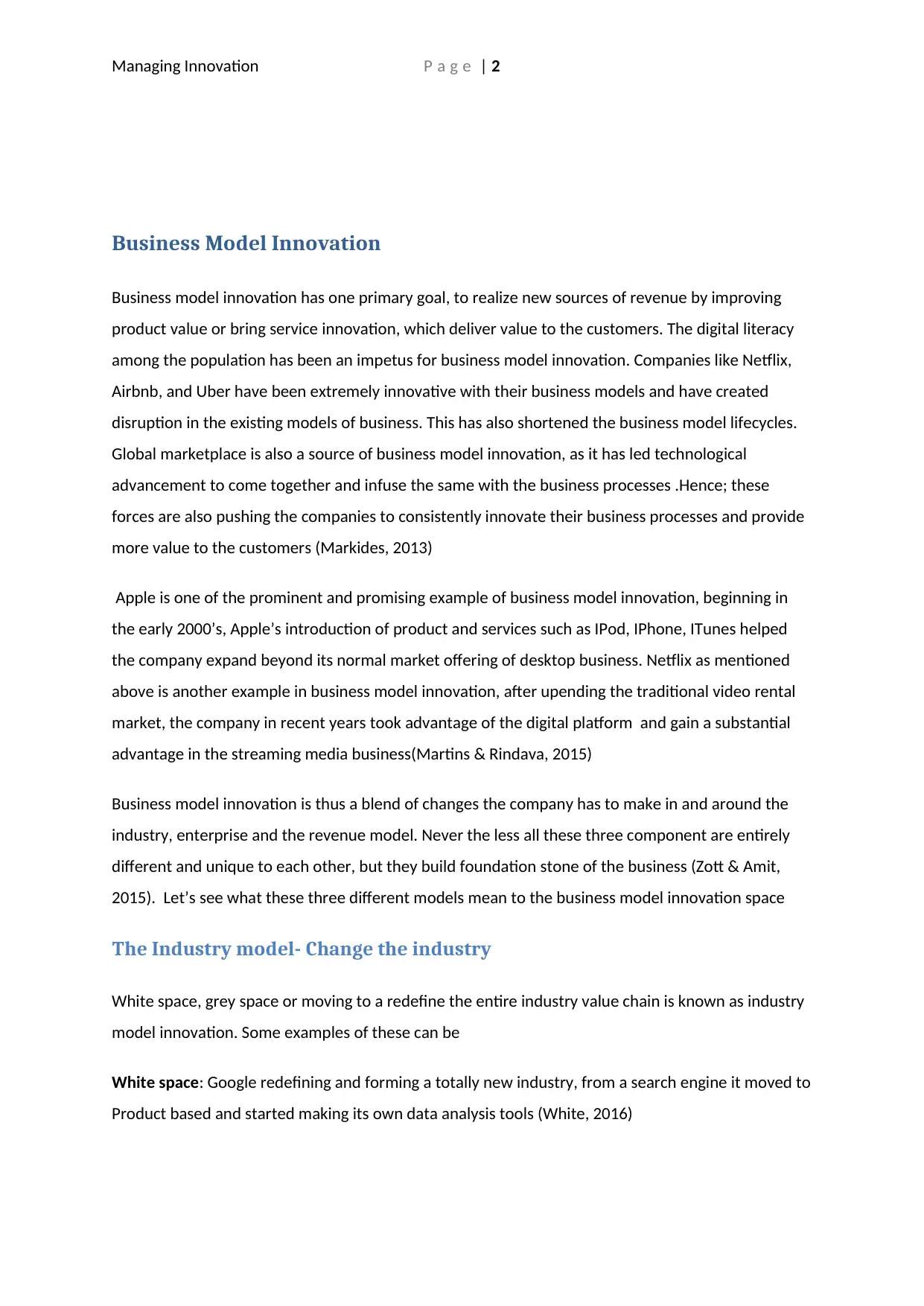
Managing Innovation P a g e | 2
Business Model Innovation
Business model innovation has one primary goal, to realize new sources of revenue by improving
product value or bring service innovation, which deliver value to the customers. The digital literacy
among the population has been an impetus for business model innovation. Companies like Netflix,
Airbnb, and Uber have been extremely innovative with their business models and have created
disruption in the existing models of business. This has also shortened the business model lifecycles.
Global marketplace is also a source of business model innovation, as it has led technological
advancement to come together and infuse the same with the business processes .Hence; these
forces are also pushing the companies to consistently innovate their business processes and provide
more value to the customers (Markides, 2013)
Apple is one of the prominent and promising example of business model innovation, beginning in
the early 2000’s, Apple’s introduction of product and services such as IPod, IPhone, ITunes helped
the company expand beyond its normal market offering of desktop business. Netflix as mentioned
above is another example in business model innovation, after upending the traditional video rental
market, the company in recent years took advantage of the digital platform and gain a substantial
advantage in the streaming media business(Martins & Rindava, 2015)
Business model innovation is thus a blend of changes the company has to make in and around the
industry, enterprise and the revenue model. Never the less all these three component are entirely
different and unique to each other, but they build foundation stone of the business (Zott & Amit,
2015). Let’s see what these three different models mean to the business model innovation space
The Industry model- Change the industry
White space, grey space or moving to a redefine the entire industry value chain is known as industry
model innovation. Some examples of these can be
White space: Google redefining and forming a totally new industry, from a search engine it moved to
Product based and started making its own data analysis tools (White, 2016)
Business Model Innovation
Business model innovation has one primary goal, to realize new sources of revenue by improving
product value or bring service innovation, which deliver value to the customers. The digital literacy
among the population has been an impetus for business model innovation. Companies like Netflix,
Airbnb, and Uber have been extremely innovative with their business models and have created
disruption in the existing models of business. This has also shortened the business model lifecycles.
Global marketplace is also a source of business model innovation, as it has led technological
advancement to come together and infuse the same with the business processes .Hence; these
forces are also pushing the companies to consistently innovate their business processes and provide
more value to the customers (Markides, 2013)
Apple is one of the prominent and promising example of business model innovation, beginning in
the early 2000’s, Apple’s introduction of product and services such as IPod, IPhone, ITunes helped
the company expand beyond its normal market offering of desktop business. Netflix as mentioned
above is another example in business model innovation, after upending the traditional video rental
market, the company in recent years took advantage of the digital platform and gain a substantial
advantage in the streaming media business(Martins & Rindava, 2015)
Business model innovation is thus a blend of changes the company has to make in and around the
industry, enterprise and the revenue model. Never the less all these three component are entirely
different and unique to each other, but they build foundation stone of the business (Zott & Amit,
2015). Let’s see what these three different models mean to the business model innovation space
The Industry model- Change the industry
White space, grey space or moving to a redefine the entire industry value chain is known as industry
model innovation. Some examples of these can be
White space: Google redefining and forming a totally new industry, from a search engine it moved to
Product based and started making its own data analysis tools (White, 2016)
⊘ This is a preview!⊘
Do you want full access?
Subscribe today to unlock all pages.

Trusted by 1+ million students worldwide
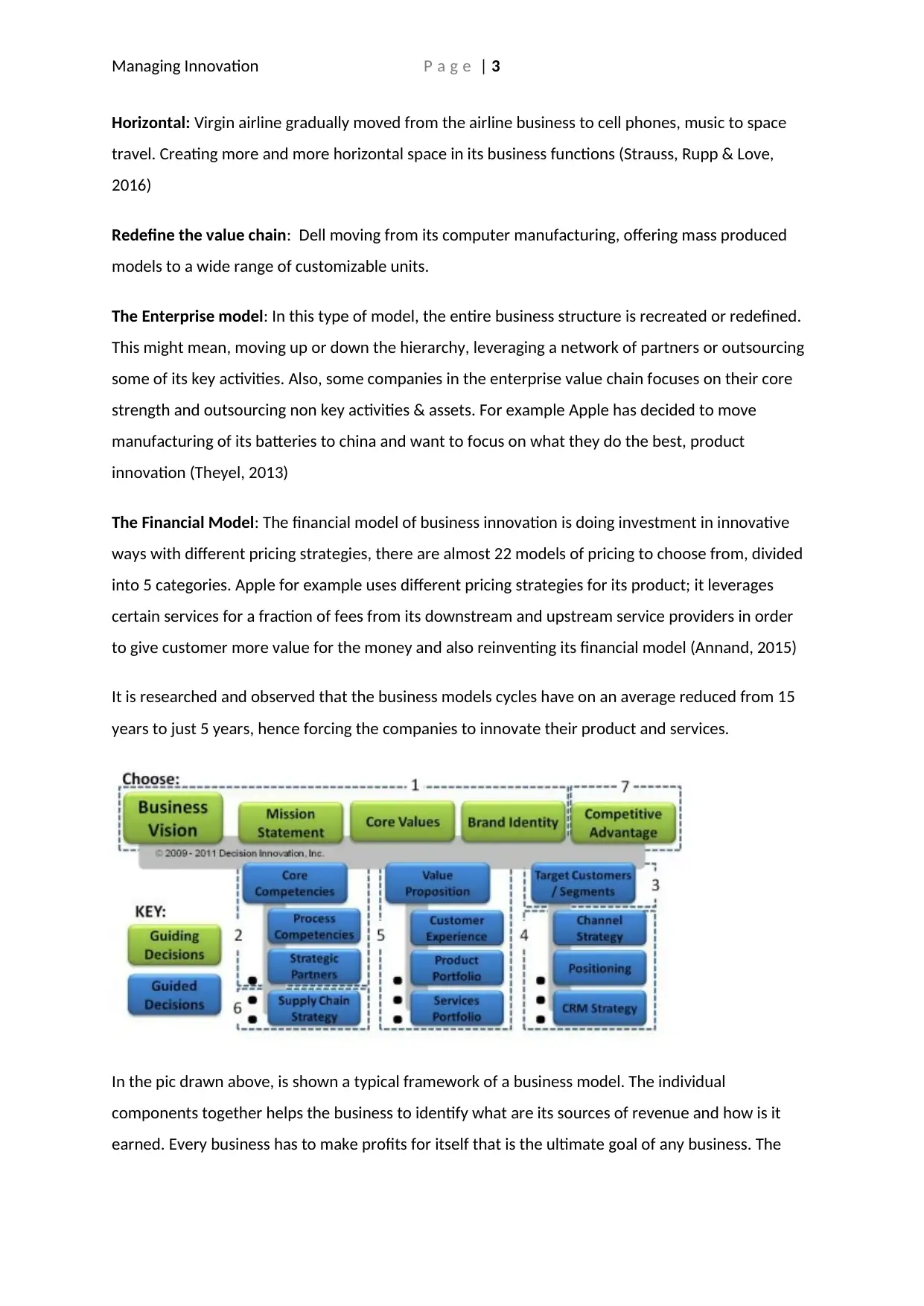
Managing Innovation P a g e | 3
Horizontal: Virgin airline gradually moved from the airline business to cell phones, music to space
travel. Creating more and more horizontal space in its business functions (Strauss, Rupp & Love,
2016)
Redefine the value chain: Dell moving from its computer manufacturing, offering mass produced
models to a wide range of customizable units.
The Enterprise model: In this type of model, the entire business structure is recreated or redefined.
This might mean, moving up or down the hierarchy, leveraging a network of partners or outsourcing
some of its key activities. Also, some companies in the enterprise value chain focuses on their core
strength and outsourcing non key activities & assets. For example Apple has decided to move
manufacturing of its batteries to china and want to focus on what they do the best, product
innovation (Theyel, 2013)
The Financial Model: The financial model of business innovation is doing investment in innovative
ways with different pricing strategies, there are almost 22 models of pricing to choose from, divided
into 5 categories. Apple for example uses different pricing strategies for its product; it leverages
certain services for a fraction of fees from its downstream and upstream service providers in order
to give customer more value for the money and also reinventing its financial model (Annand, 2015)
It is researched and observed that the business models cycles have on an average reduced from 15
years to just 5 years, hence forcing the companies to innovate their product and services.
In the pic drawn above, is shown a typical framework of a business model. The individual
components together helps the business to identify what are its sources of revenue and how is it
earned. Every business has to make profits for itself that is the ultimate goal of any business. The
Horizontal: Virgin airline gradually moved from the airline business to cell phones, music to space
travel. Creating more and more horizontal space in its business functions (Strauss, Rupp & Love,
2016)
Redefine the value chain: Dell moving from its computer manufacturing, offering mass produced
models to a wide range of customizable units.
The Enterprise model: In this type of model, the entire business structure is recreated or redefined.
This might mean, moving up or down the hierarchy, leveraging a network of partners or outsourcing
some of its key activities. Also, some companies in the enterprise value chain focuses on their core
strength and outsourcing non key activities & assets. For example Apple has decided to move
manufacturing of its batteries to china and want to focus on what they do the best, product
innovation (Theyel, 2013)
The Financial Model: The financial model of business innovation is doing investment in innovative
ways with different pricing strategies, there are almost 22 models of pricing to choose from, divided
into 5 categories. Apple for example uses different pricing strategies for its product; it leverages
certain services for a fraction of fees from its downstream and upstream service providers in order
to give customer more value for the money and also reinventing its financial model (Annand, 2015)
It is researched and observed that the business models cycles have on an average reduced from 15
years to just 5 years, hence forcing the companies to innovate their product and services.
In the pic drawn above, is shown a typical framework of a business model. The individual
components together helps the business to identify what are its sources of revenue and how is it
earned. Every business has to make profits for itself that is the ultimate goal of any business. The
Paraphrase This Document
Need a fresh take? Get an instant paraphrase of this document with our AI Paraphraser
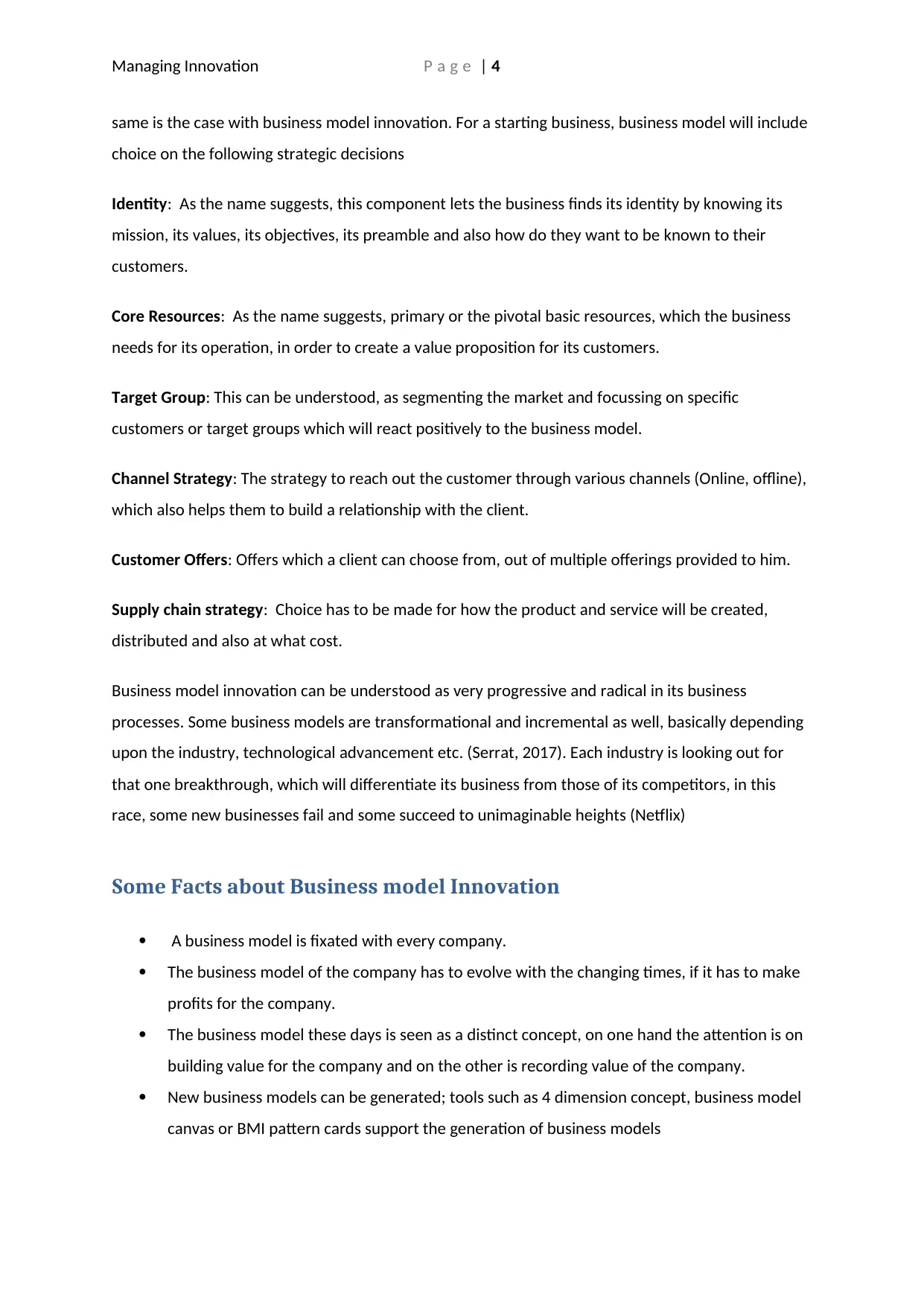
Managing Innovation P a g e | 4
same is the case with business model innovation. For a starting business, business model will include
choice on the following strategic decisions
Identity: As the name suggests, this component lets the business finds its identity by knowing its
mission, its values, its objectives, its preamble and also how do they want to be known to their
customers.
Core Resources: As the name suggests, primary or the pivotal basic resources, which the business
needs for its operation, in order to create a value proposition for its customers.
Target Group: This can be understood, as segmenting the market and focussing on specific
customers or target groups which will react positively to the business model.
Channel Strategy: The strategy to reach out the customer through various channels (Online, offline),
which also helps them to build a relationship with the client.
Customer Offers: Offers which a client can choose from, out of multiple offerings provided to him.
Supply chain strategy: Choice has to be made for how the product and service will be created,
distributed and also at what cost.
Business model innovation can be understood as very progressive and radical in its business
processes. Some business models are transformational and incremental as well, basically depending
upon the industry, technological advancement etc. (Serrat, 2017). Each industry is looking out for
that one breakthrough, which will differentiate its business from those of its competitors, in this
race, some new businesses fail and some succeed to unimaginable heights (Netflix)
Some Facts about Business model Innovation
A business model is fixated with every company.
The business model of the company has to evolve with the changing times, if it has to make
profits for the company.
The business model these days is seen as a distinct concept, on one hand the attention is on
building value for the company and on the other is recording value of the company.
New business models can be generated; tools such as 4 dimension concept, business model
canvas or BMI pattern cards support the generation of business models
same is the case with business model innovation. For a starting business, business model will include
choice on the following strategic decisions
Identity: As the name suggests, this component lets the business finds its identity by knowing its
mission, its values, its objectives, its preamble and also how do they want to be known to their
customers.
Core Resources: As the name suggests, primary or the pivotal basic resources, which the business
needs for its operation, in order to create a value proposition for its customers.
Target Group: This can be understood, as segmenting the market and focussing on specific
customers or target groups which will react positively to the business model.
Channel Strategy: The strategy to reach out the customer through various channels (Online, offline),
which also helps them to build a relationship with the client.
Customer Offers: Offers which a client can choose from, out of multiple offerings provided to him.
Supply chain strategy: Choice has to be made for how the product and service will be created,
distributed and also at what cost.
Business model innovation can be understood as very progressive and radical in its business
processes. Some business models are transformational and incremental as well, basically depending
upon the industry, technological advancement etc. (Serrat, 2017). Each industry is looking out for
that one breakthrough, which will differentiate its business from those of its competitors, in this
race, some new businesses fail and some succeed to unimaginable heights (Netflix)
Some Facts about Business model Innovation
A business model is fixated with every company.
The business model of the company has to evolve with the changing times, if it has to make
profits for the company.
The business model these days is seen as a distinct concept, on one hand the attention is on
building value for the company and on the other is recording value of the company.
New business models can be generated; tools such as 4 dimension concept, business model
canvas or BMI pattern cards support the generation of business models
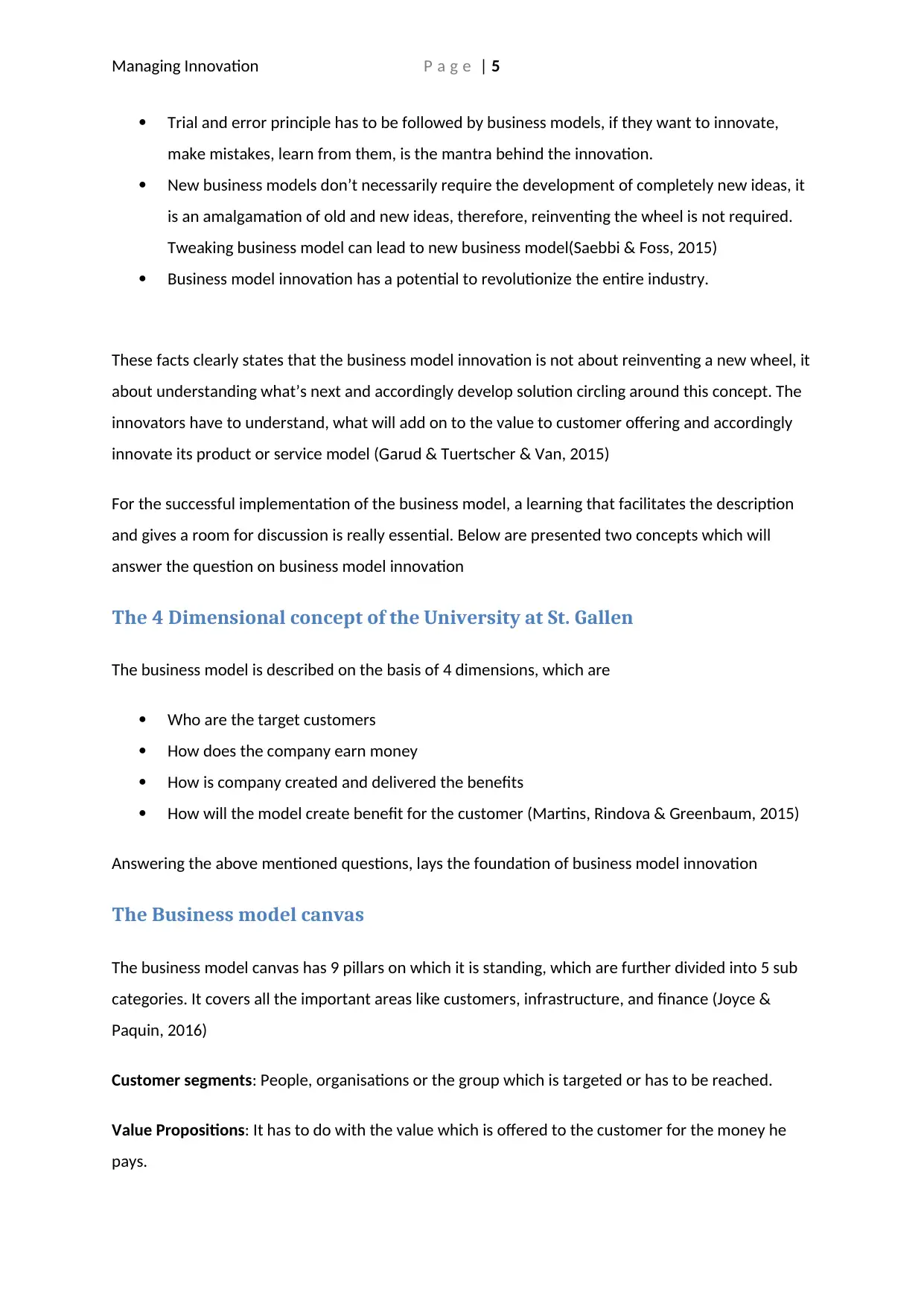
Managing Innovation P a g e | 5
Trial and error principle has to be followed by business models, if they want to innovate,
make mistakes, learn from them, is the mantra behind the innovation.
New business models don’t necessarily require the development of completely new ideas, it
is an amalgamation of old and new ideas, therefore, reinventing the wheel is not required.
Tweaking business model can lead to new business model(Saebbi & Foss, 2015)
Business model innovation has a potential to revolutionize the entire industry.
These facts clearly states that the business model innovation is not about reinventing a new wheel, it
about understanding what’s next and accordingly develop solution circling around this concept. The
innovators have to understand, what will add on to the value to customer offering and accordingly
innovate its product or service model (Garud & Tuertscher & Van, 2015)
For the successful implementation of the business model, a learning that facilitates the description
and gives a room for discussion is really essential. Below are presented two concepts which will
answer the question on business model innovation
The 4 Dimensional concept of the University at St. Gallen
The business model is described on the basis of 4 dimensions, which are
Who are the target customers
How does the company earn money
How is company created and delivered the benefits
How will the model create benefit for the customer (Martins, Rindova & Greenbaum, 2015)
Answering the above mentioned questions, lays the foundation of business model innovation
The Business model canvas
The business model canvas has 9 pillars on which it is standing, which are further divided into 5 sub
categories. It covers all the important areas like customers, infrastructure, and finance (Joyce &
Paquin, 2016)
Customer segments: People, organisations or the group which is targeted or has to be reached.
Value Propositions: It has to do with the value which is offered to the customer for the money he
pays.
Trial and error principle has to be followed by business models, if they want to innovate,
make mistakes, learn from them, is the mantra behind the innovation.
New business models don’t necessarily require the development of completely new ideas, it
is an amalgamation of old and new ideas, therefore, reinventing the wheel is not required.
Tweaking business model can lead to new business model(Saebbi & Foss, 2015)
Business model innovation has a potential to revolutionize the entire industry.
These facts clearly states that the business model innovation is not about reinventing a new wheel, it
about understanding what’s next and accordingly develop solution circling around this concept. The
innovators have to understand, what will add on to the value to customer offering and accordingly
innovate its product or service model (Garud & Tuertscher & Van, 2015)
For the successful implementation of the business model, a learning that facilitates the description
and gives a room for discussion is really essential. Below are presented two concepts which will
answer the question on business model innovation
The 4 Dimensional concept of the University at St. Gallen
The business model is described on the basis of 4 dimensions, which are
Who are the target customers
How does the company earn money
How is company created and delivered the benefits
How will the model create benefit for the customer (Martins, Rindova & Greenbaum, 2015)
Answering the above mentioned questions, lays the foundation of business model innovation
The Business model canvas
The business model canvas has 9 pillars on which it is standing, which are further divided into 5 sub
categories. It covers all the important areas like customers, infrastructure, and finance (Joyce &
Paquin, 2016)
Customer segments: People, organisations or the group which is targeted or has to be reached.
Value Propositions: It has to do with the value which is offered to the customer for the money he
pays.
⊘ This is a preview!⊘
Do you want full access?
Subscribe today to unlock all pages.

Trusted by 1+ million students worldwide
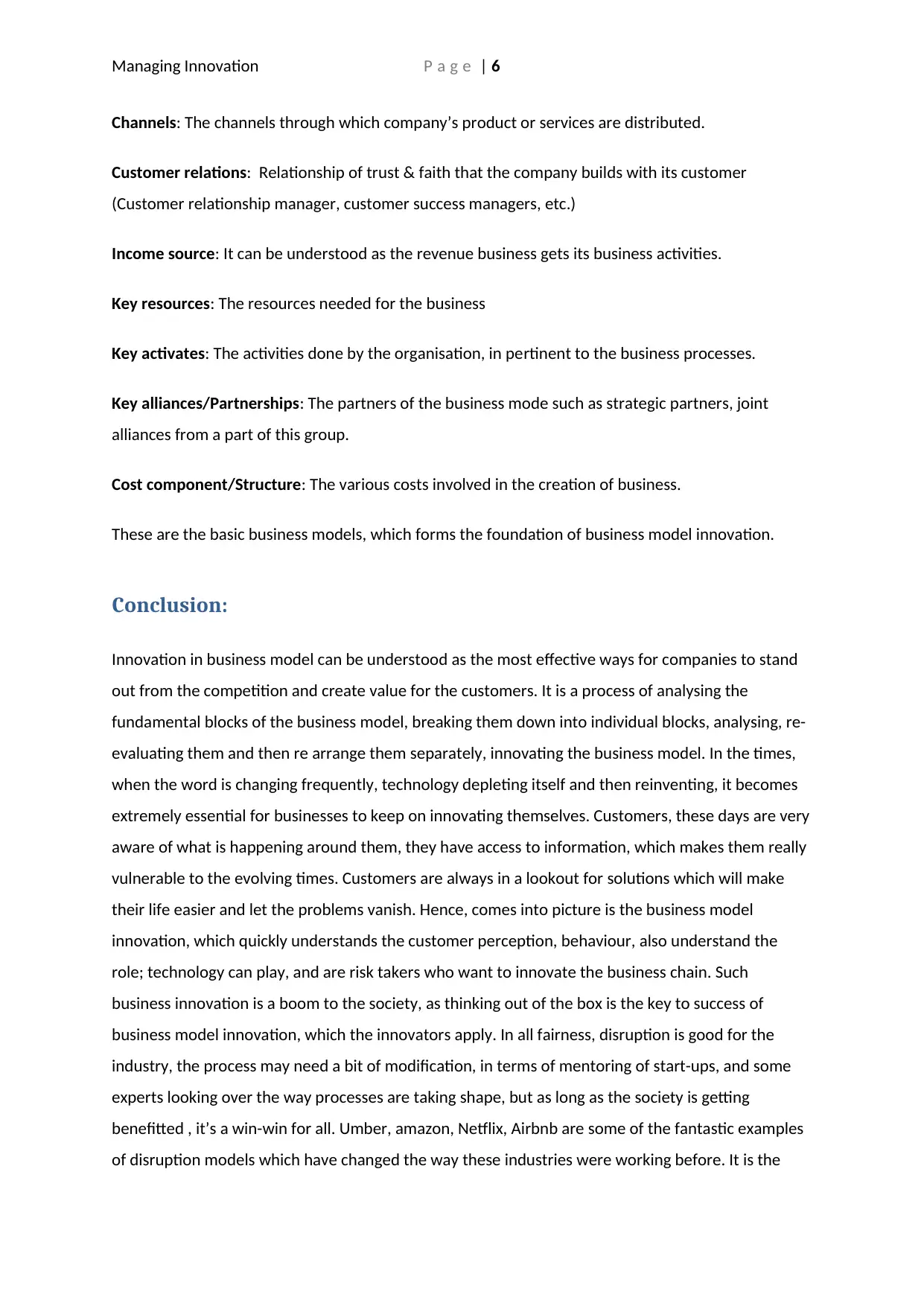
Managing Innovation P a g e | 6
Channels: The channels through which company’s product or services are distributed.
Customer relations: Relationship of trust & faith that the company builds with its customer
(Customer relationship manager, customer success managers, etc.)
Income source: It can be understood as the revenue business gets its business activities.
Key resources: The resources needed for the business
Key activates: The activities done by the organisation, in pertinent to the business processes.
Key alliances/Partnerships: The partners of the business mode such as strategic partners, joint
alliances from a part of this group.
Cost component/Structure: The various costs involved in the creation of business.
These are the basic business models, which forms the foundation of business model innovation.
Conclusion:
Innovation in business model can be understood as the most effective ways for companies to stand
out from the competition and create value for the customers. It is a process of analysing the
fundamental blocks of the business model, breaking them down into individual blocks, analysing, re-
evaluating them and then re arrange them separately, innovating the business model. In the times,
when the word is changing frequently, technology depleting itself and then reinventing, it becomes
extremely essential for businesses to keep on innovating themselves. Customers, these days are very
aware of what is happening around them, they have access to information, which makes them really
vulnerable to the evolving times. Customers are always in a lookout for solutions which will make
their life easier and let the problems vanish. Hence, comes into picture is the business model
innovation, which quickly understands the customer perception, behaviour, also understand the
role; technology can play, and are risk takers who want to innovate the business chain. Such
business innovation is a boom to the society, as thinking out of the box is the key to success of
business model innovation, which the innovators apply. In all fairness, disruption is good for the
industry, the process may need a bit of modification, in terms of mentoring of start-ups, and some
experts looking over the way processes are taking shape, but as long as the society is getting
benefitted , it’s a win-win for all. Umber, amazon, Netflix, Airbnb are some of the fantastic examples
of disruption models which have changed the way these industries were working before. It is the
Channels: The channels through which company’s product or services are distributed.
Customer relations: Relationship of trust & faith that the company builds with its customer
(Customer relationship manager, customer success managers, etc.)
Income source: It can be understood as the revenue business gets its business activities.
Key resources: The resources needed for the business
Key activates: The activities done by the organisation, in pertinent to the business processes.
Key alliances/Partnerships: The partners of the business mode such as strategic partners, joint
alliances from a part of this group.
Cost component/Structure: The various costs involved in the creation of business.
These are the basic business models, which forms the foundation of business model innovation.
Conclusion:
Innovation in business model can be understood as the most effective ways for companies to stand
out from the competition and create value for the customers. It is a process of analysing the
fundamental blocks of the business model, breaking them down into individual blocks, analysing, re-
evaluating them and then re arrange them separately, innovating the business model. In the times,
when the word is changing frequently, technology depleting itself and then reinventing, it becomes
extremely essential for businesses to keep on innovating themselves. Customers, these days are very
aware of what is happening around them, they have access to information, which makes them really
vulnerable to the evolving times. Customers are always in a lookout for solutions which will make
their life easier and let the problems vanish. Hence, comes into picture is the business model
innovation, which quickly understands the customer perception, behaviour, also understand the
role; technology can play, and are risk takers who want to innovate the business chain. Such
business innovation is a boom to the society, as thinking out of the box is the key to success of
business model innovation, which the innovators apply. In all fairness, disruption is good for the
industry, the process may need a bit of modification, in terms of mentoring of start-ups, and some
experts looking over the way processes are taking shape, but as long as the society is getting
benefitted , it’s a win-win for all. Umber, amazon, Netflix, Airbnb are some of the fantastic examples
of disruption models which have changed the way these industries were working before. It is the
Paraphrase This Document
Need a fresh take? Get an instant paraphrase of this document with our AI Paraphraser
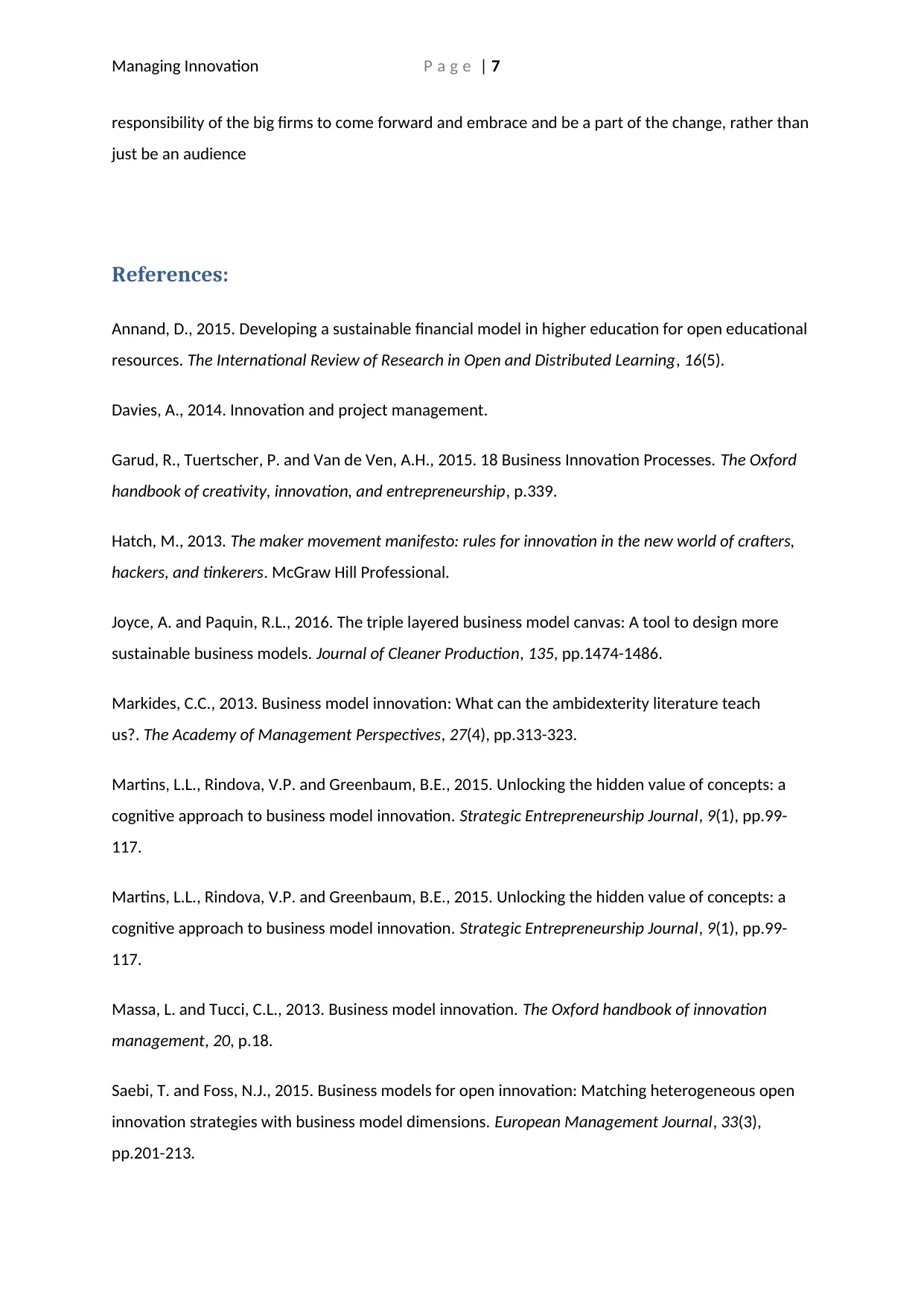
Managing Innovation P a g e | 7
responsibility of the big firms to come forward and embrace and be a part of the change, rather than
just be an audience
References:
Annand, D., 2015. Developing a sustainable financial model in higher education for open educational
resources. The International Review of Research in Open and Distributed Learning, 16(5).
Davies, A., 2014. Innovation and project management.
Garud, R., Tuertscher, P. and Van de Ven, A.H., 2015. 18 Business Innovation Processes. The Oxford
handbook of creativity, innovation, and entrepreneurship, p.339.
Hatch, M., 2013. The maker movement manifesto: rules for innovation in the new world of crafters,
hackers, and tinkerers. McGraw Hill Professional.
Joyce, A. and Paquin, R.L., 2016. The triple layered business model canvas: A tool to design more
sustainable business models. Journal of Cleaner Production, 135, pp.1474-1486.
Markides, C.C., 2013. Business model innovation: What can the ambidexterity literature teach
us?. The Academy of Management Perspectives, 27(4), pp.313-323.
Martins, L.L., Rindova, V.P. and Greenbaum, B.E., 2015. Unlocking the hidden value of concepts: a
cognitive approach to business model innovation. Strategic Entrepreneurship Journal, 9(1), pp.99-
117.
Martins, L.L., Rindova, V.P. and Greenbaum, B.E., 2015. Unlocking the hidden value of concepts: a
cognitive approach to business model innovation. Strategic Entrepreneurship Journal, 9(1), pp.99-
117.
Massa, L. and Tucci, C.L., 2013. Business model innovation. The Oxford handbook of innovation
management, 20, p.18.
Saebi, T. and Foss, N.J., 2015. Business models for open innovation: Matching heterogeneous open
innovation strategies with business model dimensions. European Management Journal, 33(3),
pp.201-213.
responsibility of the big firms to come forward and embrace and be a part of the change, rather than
just be an audience
References:
Annand, D., 2015. Developing a sustainable financial model in higher education for open educational
resources. The International Review of Research in Open and Distributed Learning, 16(5).
Davies, A., 2014. Innovation and project management.
Garud, R., Tuertscher, P. and Van de Ven, A.H., 2015. 18 Business Innovation Processes. The Oxford
handbook of creativity, innovation, and entrepreneurship, p.339.
Hatch, M., 2013. The maker movement manifesto: rules for innovation in the new world of crafters,
hackers, and tinkerers. McGraw Hill Professional.
Joyce, A. and Paquin, R.L., 2016. The triple layered business model canvas: A tool to design more
sustainable business models. Journal of Cleaner Production, 135, pp.1474-1486.
Markides, C.C., 2013. Business model innovation: What can the ambidexterity literature teach
us?. The Academy of Management Perspectives, 27(4), pp.313-323.
Martins, L.L., Rindova, V.P. and Greenbaum, B.E., 2015. Unlocking the hidden value of concepts: a
cognitive approach to business model innovation. Strategic Entrepreneurship Journal, 9(1), pp.99-
117.
Martins, L.L., Rindova, V.P. and Greenbaum, B.E., 2015. Unlocking the hidden value of concepts: a
cognitive approach to business model innovation. Strategic Entrepreneurship Journal, 9(1), pp.99-
117.
Massa, L. and Tucci, C.L., 2013. Business model innovation. The Oxford handbook of innovation
management, 20, p.18.
Saebi, T. and Foss, N.J., 2015. Business models for open innovation: Matching heterogeneous open
innovation strategies with business model dimensions. European Management Journal, 33(3),
pp.201-213.
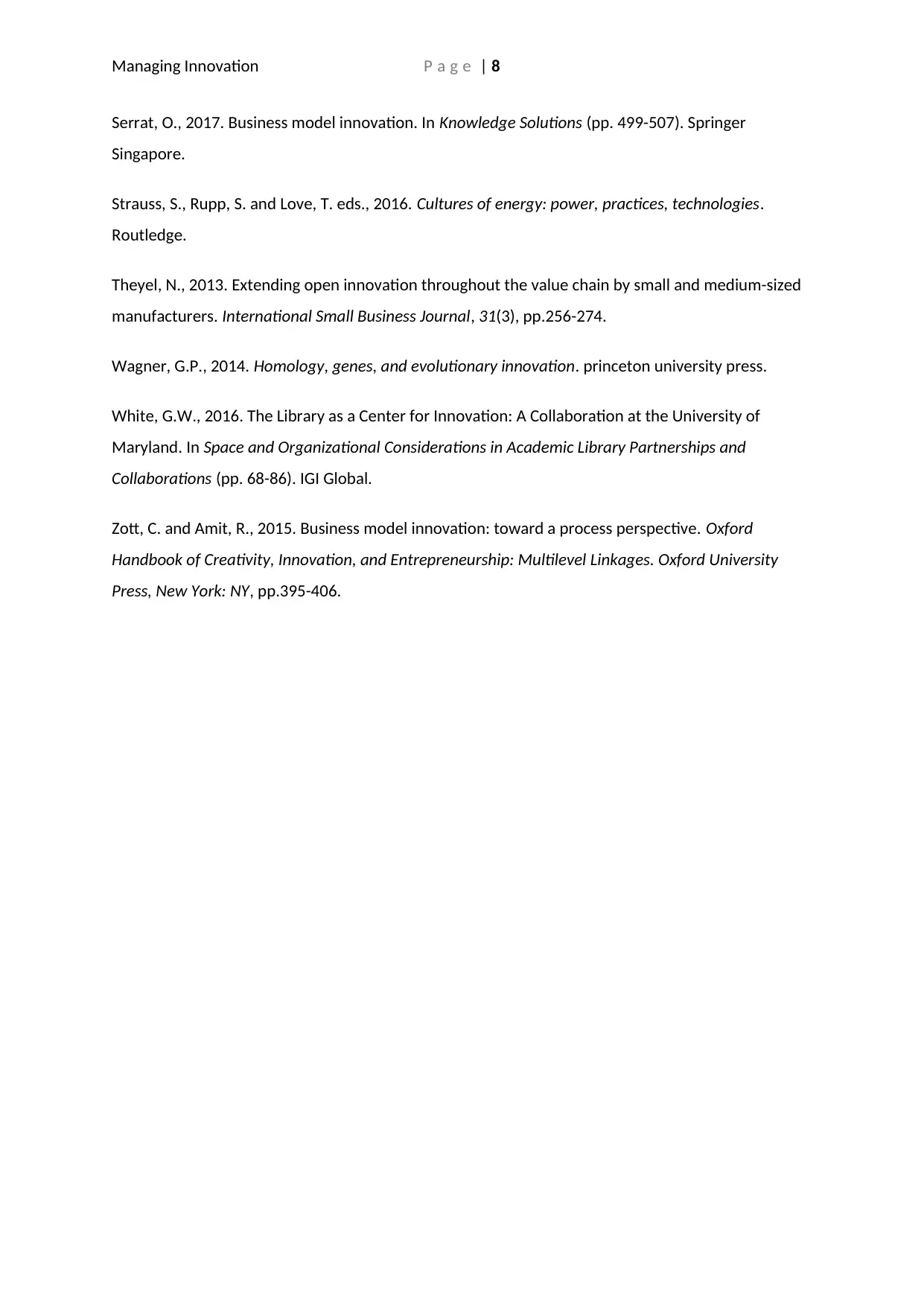
Managing Innovation P a g e | 8
Serrat, O., 2017. Business model innovation. In Knowledge Solutions (pp. 499-507). Springer
Singapore.
Strauss, S., Rupp, S. and Love, T. eds., 2016. Cultures of energy: power, practices, technologies.
Routledge.
Theyel, N., 2013. Extending open innovation throughout the value chain by small and medium-sized
manufacturers. International Small Business Journal, 31(3), pp.256-274.
Wagner, G.P., 2014. Homology, genes, and evolutionary innovation. princeton university press.
White, G.W., 2016. The Library as a Center for Innovation: A Collaboration at the University of
Maryland. In Space and Organizational Considerations in Academic Library Partnerships and
Collaborations (pp. 68-86). IGI Global.
Zott, C. and Amit, R., 2015. Business model innovation: toward a process perspective. Oxford
Handbook of Creativity, Innovation, and Entrepreneurship: Multilevel Linkages. Oxford University
Press, New York: NY, pp.395-406.
Serrat, O., 2017. Business model innovation. In Knowledge Solutions (pp. 499-507). Springer
Singapore.
Strauss, S., Rupp, S. and Love, T. eds., 2016. Cultures of energy: power, practices, technologies.
Routledge.
Theyel, N., 2013. Extending open innovation throughout the value chain by small and medium-sized
manufacturers. International Small Business Journal, 31(3), pp.256-274.
Wagner, G.P., 2014. Homology, genes, and evolutionary innovation. princeton university press.
White, G.W., 2016. The Library as a Center for Innovation: A Collaboration at the University of
Maryland. In Space and Organizational Considerations in Academic Library Partnerships and
Collaborations (pp. 68-86). IGI Global.
Zott, C. and Amit, R., 2015. Business model innovation: toward a process perspective. Oxford
Handbook of Creativity, Innovation, and Entrepreneurship: Multilevel Linkages. Oxford University
Press, New York: NY, pp.395-406.
⊘ This is a preview!⊘
Do you want full access?
Subscribe today to unlock all pages.

Trusted by 1+ million students worldwide
1 out of 9
Related Documents
Your All-in-One AI-Powered Toolkit for Academic Success.
+13062052269
info@desklib.com
Available 24*7 on WhatsApp / Email
![[object Object]](/_next/static/media/star-bottom.7253800d.svg)
Unlock your academic potential
Copyright © 2020–2025 A2Z Services. All Rights Reserved. Developed and managed by ZUCOL.





